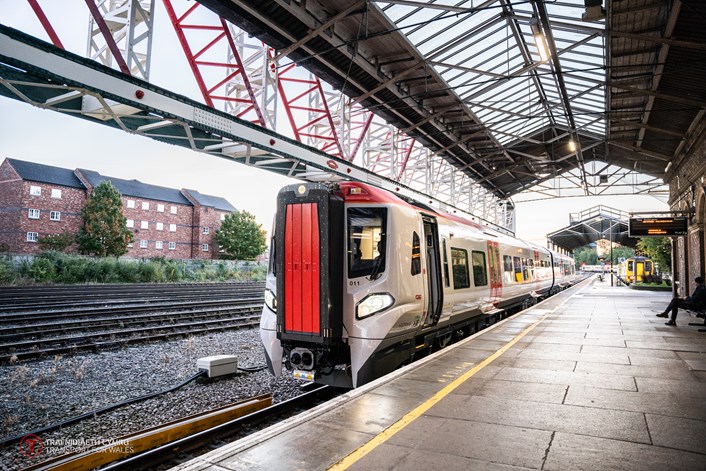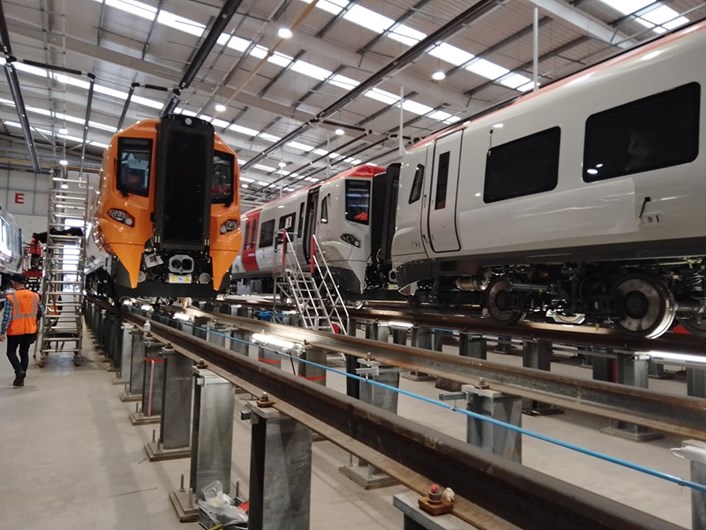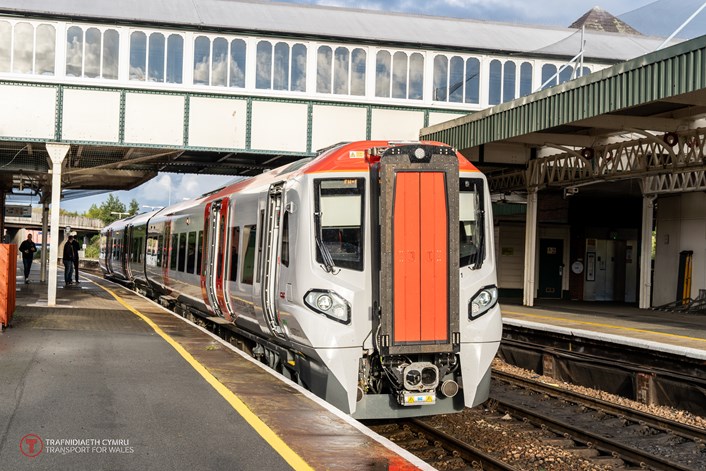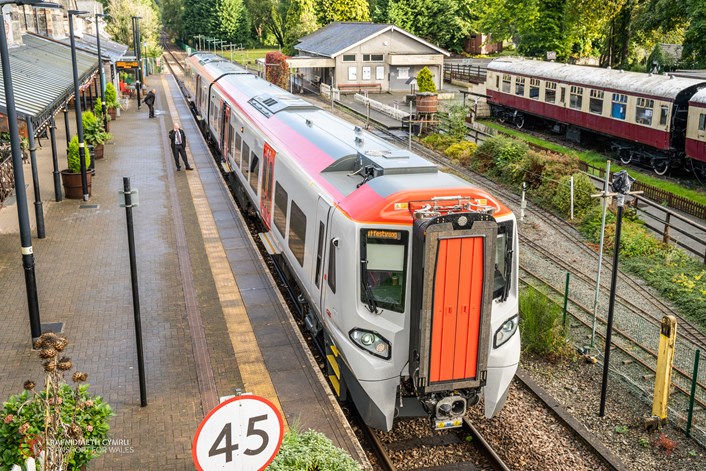27 Jan 2023
It’s taken four years of hard work across the rail industry, but Transport for Wales’ first brand new trains have entered passenger service on the Wales and Borders network.
The Class 197 trains have been built for TfW by train manufacturer CAF, as part of an £800 million investment to introduce brand new trains to services throughout the network.
The order for the 77 Class 197 trains – 51 two-car and 26 three-car – was officially confirmed in 2018, when details of our plans to transform the Wales and Borders rail service were first announced. Since then, we’ve been working closely with CAF and other industry partners to hone the design to the ideal specification for our services.
Designing new trains
An important part of this was working to find a balance between seating capacity and accessible toilets, seating layout and cycle spaces. We also had to ensure the design of the layout would help improve reliability and punctuality, as a number of the routes the trains will operate on are busy with large numbers of passengers and frequent services, and worked with colleagues to ensure the design worked for the people who will be operating the trains every day.
The design work ensures that the new trains will provide a much-improved customer experience. Information screens provide up-to-date information to customers about the service, and each seat will have electronic charging points.
Accessibility is a key priority, with wider doors allowing easier access and dedicated spaces for people using wheelchair that are separate from the spaces for cycles and prams. We were supported in developing accessibility features by our members of our Accessibility and Inclusion Panel, who have provided constructive feedback throughout the design process, and by customers and stakeholders who have visited the mock-up trains on display in Taff’s Well over the past year. Designing the trains has been a two-way process and we’re very grateful for the input of everyone who has taken part and helped us improve the design down to the smallest details.
Bringing the trains into service
After three years of design, manufacturing and assembly work, the first train rolled off the production line at CAF’s factory in Newport, South Wales in May 2021, and began an intensive testing and crew training programme to make sure they were ready to enter passenger service, in line with rail industry standards.
More trains will enter service gradually over the next few months. This will allow us to run them coupled together on many of our busiest services to provide increased capacity – something that is currently challenging for us to do, due to the number of different types of train we have. Having a standard fleet of trains used on most routes will provide us with more resilience and make our operations simpler.
With modern, efficient engines that feature the most up-to-date technology, the Class 197s have reduced emissions and fuel consumption compared to our current fleet of diesel trains, helping contribute to our target of being carbon neutral by 2030. However, they do not sacrifice performance: the 197s will enable faster journeys on our long-distance routes thanks to their better acceleration, and our timetables will be adapted to reflect this once more trains enter service.
When will I see the Class 197s on my line?
The Class 197s will appear on most routes on the Wales and Borders network but this will be a gradual process that will take several months. Beginning with the Conwy Valley Line between Llandudno and Blaenau Ffestiniog, they will initially be rolled out on routes from their depot in Chester. This will include the services between Chester and Liverpool Lime Street, between Wrexham and Bidston, and along the North Wales Coast Line to Holyhead.
Focus will shift in 2023 as we train our crews in South Wales ahead of their introduction on more routes. This will include the long-distance services between Holyhead and Cardiff Central, and services to Manchester – both of which will be shared with the Mark 4 intercity trains – and services in West Wales to Milford Haven, Fishguard Harbour and Pembroke Dock. They will also take over the South Wales Metro services to Ebbw Vale, Maesteg and Cheltenham, replacing the departing Class 170s on an interim basis ahead of the introduction of the Class 231 Metro trains.
The last route to receive 197s will be the Cambrian Line. This is due to the line’s unique ETCS in-cab signalling and control system, which has led to the development of a batch of trains fitted with the specialist equipment. These 21 trains will be based at Machynlleth depot and will be dedicated to services between Birmingham, Aberystwyth and Pwllheli. Due to the specific nature of the systems, these require additional testing before entering service, which is already underway with the first train. Our Class 158 fleet, which currently operate the services on the Cambrian Line, will remain in service until the ETCS-fitted 197s are introduced.
Where else will I see new trains?
A separate fleet of 71 brand new trains is being developed for the South Wales Metro in partnership with train manufacturer Stadler. Testing of the first Class 231 Metro trains is already well underway, along with the training of traincrew. We currently expect these to enter service in early 2023. These trains will also provide a significantly improved customer experience in line with the Class 197s, including more capacity and improved accessibility.
These will be followed by the Class 398 tram-trains, which are being developed for the Core Valley Lines routes between Cardiff and Treherbert, Aberdare and Merthyr Tydfil. These electric trains will be powered by batteries and overhead wires currently being installed as part of the Metro transformation works.
Similarly, the Class 756 tri-mode trains being developed for services to Rhymney, Coryton and the Vale of Glamorgan will be powered by batteries, overhead wires, and diesel engines for running on non-electrified lines south of Cardiff. Both fleets of electric Metro trains will be introduced after the completion of the transformation work.
We’re also introducing Class 230 diesel-battery hybrid trains to the line between Wrexham and Bidston. These completely rebuilt metro-style trains, which will provide the same facilities as our brand new trains, are an early step in the development of the North Wales Metro, and are also planned to enter service in 2023.
We answered some of your frequently asked questions around our new trains and what we’re doing to increase capacity in a previous blog article, which you can read here.
What will happen to the old trains?
We have already said goodbye to a number of types of train, including the Pacers, the last of which were withdrawn from service in South Wales in May 2021. The Mark 3 intercity trains used on the Cardiff-Holyhead “Gerald of Wales” services were also withdrawn in 2020 and were replaced by our Mark 4 intercity trains in 2021.
The Class 170s, which currently operate services to Ebbw Vale, Maesteg and Cheltenham, will be the next to leave, with the last train departing for our industry colleagues at East Midlands Railway in the spring. We’ll also be withdrawing our Class 769 trains from the Rhymney Line after the Class 231s enter service.
The Class 175s, which are used on our long-distance services, will be withdrawn after more Class 197s arrive, while the Class 158s will disappear from our network after the ETCS-fitted Class 197s enter service on the Cambrian Line. The last fleet to be withdrawn will be the Class 150 Sprinters, which will finally leave us after the completion of the Core Valley Lines transformation works and the Class 398s and 756s take over South Wales Metro services.
Most of our current fleet of trains are not owned directly by Transport for Wales. They are mostly owned by Rolling Stock Owning Companies, who manage the future destinations of their trains. We lease the trains from those companies. Once the leases end, the trains will return to their owners, who will decide their next destination.








